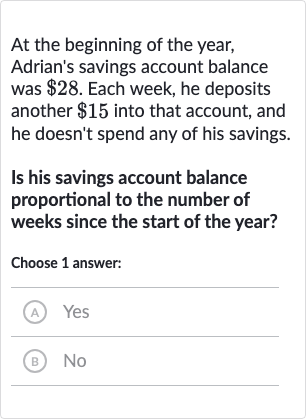AI tutor
Welcome to Bytelearn!
Let’s check out your problem:

At the beginning of the year, Adrian's savings account balance was . Each week, he deposits another into that account, and he doesn't spend any of his savings.Is his savings account balance proportional to the number of weeks since the start of the year?Choose answer:(A) Yes(B) No
Full solution
Q. At the beginning of the year, Adrian's savings account balance was . Each week, he deposits another into that account, and he doesn't spend any of his savings.Is his savings account balance proportional to the number of weeks since the start of the year?Choose answer:(A) Yes(B) No
- Define Variables: Let's define the variables:Let be the savings account balance.Let be the number of weeks since the start of the year.The initial balance is , and Adrian deposits each week.The relationship between the savings account balance and the number of weeks can be described by the equation .
- Check Proportionality: To determine if the savings account balance is proportional to the number of weeks, we need to check if the relationship between and is a direct proportion. A direct proportion means that as increases, increases at a constant rate.The equation shows that for every additional week, the savings increase by \(\(15\)), which is a constant rate.
- Direct Proportion Criteria: However, for a relationship to be proportional, the ratio of to must be constant, and the graph of the relationship must pass through the origin . Since there is an initial balance of (when ), the graph of this relationship would not pass through the origin.
- Conclusion: Therefore, the savings account balance is not proportional to the number of weeks since the start of the year because of the initial balance that does not fit the criteria for direct proportionality.
More problems from Solve a system of equations using any method: word problems
QuestionGet tutor help
QuestionGet tutor help
